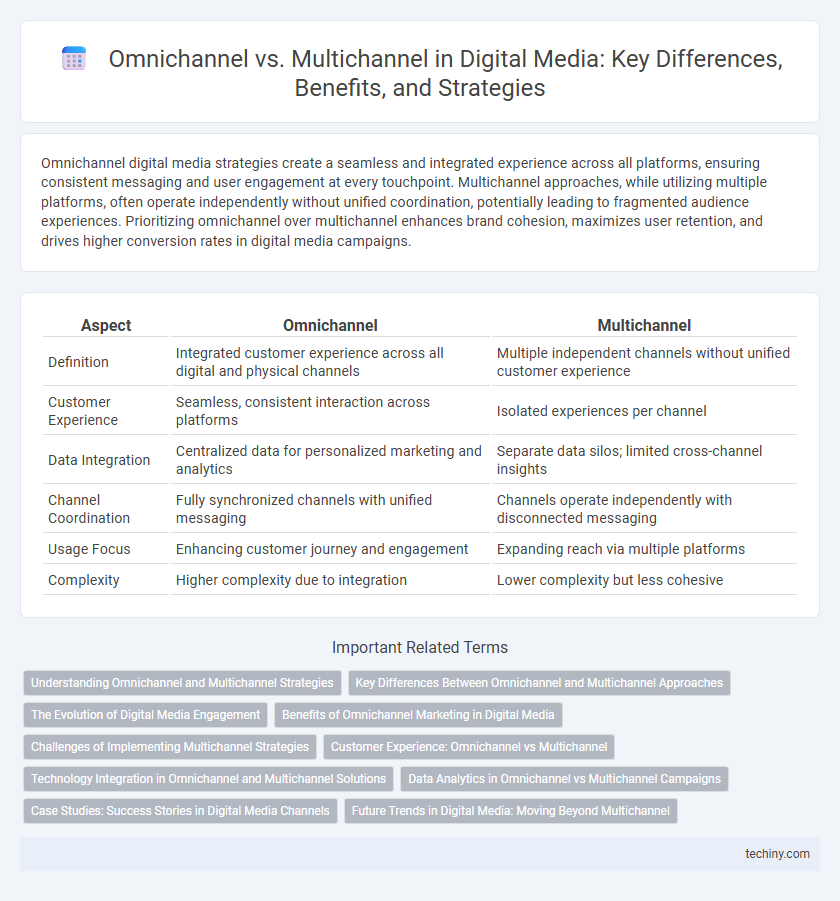Omnichannel digital media strategies create a seamless and integrated experience across all platforms, ensuring consistent messaging and user engagement at every touchpoint. Multichannel approaches, while utilizing multiple platforms, often operate independently without unified coordination, potentially leading to fragmented audience experiences. Prioritizing omnichannel over multichannel enhances brand cohesion, maximizes user retention, and drives higher conversion rates in digital media campaigns.
Table of Comparison
| Aspect | Omnichannel | Multichannel |
|---|---|---|
| Definition | Integrated customer experience across all digital and physical channels | Multiple independent channels without unified customer experience |
| Customer Experience | Seamless, consistent interaction across platforms | Isolated experiences per channel |
| Data Integration | Centralized data for personalized marketing and analytics | Separate data silos; limited cross-channel insights |
| Channel Coordination | Fully synchronized channels with unified messaging | Channels operate independently with disconnected messaging |
| Usage Focus | Enhancing customer journey and engagement | Expanding reach via multiple platforms |
| Complexity | Higher complexity due to integration | Lower complexity but less cohesive |
Understanding Omnichannel and Multichannel Strategies
Omnichannel strategies integrate multiple digital media platforms to create a seamless, consistent customer experience across all touchpoints, leveraging data analytics to personalize interactions and improve engagement. Multichannel approaches maintain separate channels where customers interact independently, often resulting in fragmented experiences and inconsistent messaging. Understanding these distinctions is crucial for digital media professionals aiming to optimize customer journeys and increase conversion rates.
Key Differences Between Omnichannel and Multichannel Approaches
Omnichannel integrates multiple digital media platforms to provide a seamless and consistent customer experience, while multichannel operates separate channels independently without unified customer data. The key difference lies in customer journey continuity, with omnichannel enabling real-time interaction across devices and touchpoints, whereas multichannel focuses on maximizing reach through various isolated channels. Omnichannel leverages integrated analytics to optimize personalized marketing strategies, contrasting with multichannel's channel-specific metrics and fragmented insights.
The Evolution of Digital Media Engagement
Omnichannel digital media engagement integrates customer interactions across multiple platforms, creating a seamless experience that enhances brand loyalty and conversion rates. Multichannel approaches, while offering various platforms, often operate in silos, limiting personalized customer journeys. The evolution from multichannel to omnichannel reflects a strategic shift toward unified data analytics and real-time personalization in digital marketing.
Benefits of Omnichannel Marketing in Digital Media
Omnichannel marketing integrates multiple digital platforms to create a seamless and consistent customer experience, enhancing brand loyalty and engagement. This approach leverages data from various channels to personalize content and optimize targeting, resulting in higher conversion rates and improved ROI. By unifying touchpoints such as social media, email, and mobile apps, omnichannel strategies drive more efficient campaign performance compared to isolated multichannel efforts.
Challenges of Implementing Multichannel Strategies
Implementing multichannel strategies faces challenges such as fragmented customer data across platforms, inconsistent brand messaging, and resource-intensive management of separate channels. Multichannel efforts often struggle to deliver a seamless customer experience due to lack of integration and difficulty tracking cross-channel user behavior. These issues hinder effective customer engagement and limit the ability to optimize marketing ROI.
Customer Experience: Omnichannel vs Multichannel
Omnichannel delivers a seamless customer experience by integrating all digital and physical touchpoints, ensuring consistent messaging and personalized interactions across channels. Multichannel focuses on providing multiple separate platforms, which can lead to fragmented experiences and inconsistent brand engagement. Brands adopting omnichannel strategies see higher customer satisfaction and loyalty due to the cohesive journey and real-time data synchronization.
Technology Integration in Omnichannel and Multichannel Solutions
Omnichannel solutions seamlessly integrate technology platforms to provide a unified customer experience across all digital and physical touchpoints, ensuring data synchronization and consistent messaging. In contrast, multichannel approaches operate disparate technology systems for each channel, resulting in fragmented customer data and inconsistent engagement. Advanced APIs, CRM integration, and real-time analytics are critical components that enable omnichannel strategies to create cohesive and personalized digital media interactions.
Data Analytics in Omnichannel vs Multichannel Campaigns
Omnichannel campaigns leverage integrated data analytics to create a unified customer view across all touchpoints, enabling personalized marketing strategies and improved attribution accuracy. Multichannel campaigns collect data independently from each channel, leading to fragmented insights and less cohesive customer experiences. The seamless data integration in omnichannel approaches drives better decision-making and higher ROI compared to the siloed data analysis typical of multichannel campaigns.
Case Studies: Success Stories in Digital Media Channels
Brands adopting omnichannel strategies report 91% higher year-over-year customer retention rates compared to multichannel approaches, as demonstrated by Starbucks' seamless integration across app, web, and in-store experiences driving $7 billion in annual revenue. Nike's use of omnichannel personalization leverages data from physical stores, mobile apps, and social media to boost direct-to-consumer sales by 35%, outperforming traditional multichannel campaigns that operate in isolated silos. Case studies highlight that omnichannel strategies create unified customer journeys, resulting in 23% higher customer satisfaction scores and more effective digital media engagement.
Future Trends in Digital Media: Moving Beyond Multichannel
Future trends in digital media emphasize the shift from multichannel to omnichannel strategies, integrating customer interactions across platforms for a seamless experience. Omnichannel approaches leverage AI-driven data analytics and personalized content delivery to enhance user engagement and drive conversions. Advancements in cross-device tracking and unified customer profiles enable brands to anticipate consumer needs and optimize touchpoints in real time.
Omnichannel vs Multichannel Infographic

 techiny.com
techiny.com